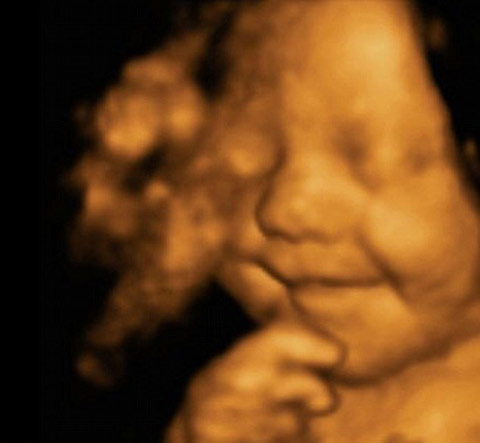|
Grinning from ear to ear, this picture shows little Leo Hargreaves was rather happy with his world – even before he was born.
And his parents believe their son may be the happiest baby in Britain as he hasn’t stopped smiling since.
The remarkable image was taken from an ultrasound scan at 31 weeks.
His mother Amy Cregg, 24, said: 'My partner Leighton and I were absolutely shocked - even the people who did my scan were amazed.
'But that was just the beginning. After he was born, he was always smiling - even in his sleep.'
Now nearly five months old, Leo has been dubbed the happiest baby in Britain.
The image is a 4D scan - increasingly popular with expectant parents to get a glimpse of how their child will look.
Rather then the grainy ‘flat’ images produced by the 2D scanners usually used by the NHS, a 4D machine stitches together pictures taken from a variety of angles to create clear three-dimensional images.
These are then recorded on video – the fourth dimension.
Ms Clegg, from Accrington, Lancashire, said she has already had modelling companies approach her trying to capture Leo’s smile.
The rehabilitation support worker said: 'I’ve been walking in the park and had people come up to me and say "What a gorgeous baby".
'I’d be interested in him doing modelling but only when he’s older.'
A spokesman for the company that performed the scan, at Babybond Ultrasound Direct in Burnley, said: 'Our sonographer who scanned Amy and her gorgeous baby was overwhelmed at her smiley baby throughout the entire scan.'
4D scans are a highly developed form of traditional ultrasound where very high frequency sound waves are used to produce images of what is inside the body.
As with older forms of ultra-sound, sound waves a emitted from a transducer, or probe, which is placed on the mother's abdomen and then moved to 'look at' areas in the uterus.
These sound waves bounce back off the foetus, helping to create a 'picture' of the child on a screen.
4D scans use the same frequency of sound waves as in a normal ultrasound.
But the sound waves are directed from many more angles, producing a 'real-time' video of the foetus as it moves and allowing scientists to say the images are in four dimensions.
|
照片上这位名叫里奥・哈格里夫斯(Leo Hargreaves)的小宝贝还未出生就已经咧着嘴笑个不停,一脸幸福的样子。
里奥的父母相信他们的儿子是全英国最快乐的宝宝,因为他的笑容从未消失。
这张与众不同的照片来自于超声波扫描,当时里奥才31周大。
里奥的母亲艾美・克莱格(Amy Cregg)今年24岁,她说:“我和我的爱人莱顿(Leighton)大感惊奇,甚至那些给我做扫描的人们也惊叹不已。不过那只是个开端。他出生之后也一直在笑,甚至在睡梦中。”
现在的里奥快有五个月大了,他已经被冠上全英国最快乐小宝宝的称号。
图像由4D扫描采集。这项技术越来越受准爸爸准妈妈的欢迎,他们迫不及待地想要一窥自家孩子的模样。
英国国民保健服务(NHS)通常使用2D扫描,由此拍出的图像是平面点状物,而4D扫描则将多角度拍摄而成的图片拼接在一起组成清晰的三维图像。
这第四个维度就是宝宝在母亲肚子里的一举一动被记录成像。
母亲克莱格女士来自兰开夏郡(Lancashire),是一位康复治疗师。她说她已经接到几家模特公司的邀请,希望能拍摄宝宝的笑容。
“我在公园里散步就会有人走过来说‘多可爱的宝宝啊’。”
“我对他做模特拍片的事很有兴趣,不过只有等他再大点儿才行。”
位于伯恩利一家名为Babybond的超声波医疗公司为里奥拍摄了4D扫描图像。该公司的新闻发言人称当时给母子两进行超声波检查的医生在看见完整的图像后也被宝宝的笑容征服了。
传统超声波技术利用超频声波成像来显示人体内的情况,而4D扫描则在此基础之上进一步发展,技术更为成熟。
不过和旧有超声波传递方式一样,声波通过母亲小腹上的传感器或者探测器进入人体,同时借助它们的移动来“瞧”子宫的内部情况。
这些声波在遇到胎儿时会被弹回,胎儿的“照片”也就能显示在屏幕上了。
4D扫描的声波频率和普通超声波技术使用的相同。
只是4D的声波能多角度帮助纪录胎儿在母体内的活动并形成一部“实时”动画。科学家们也有理由称其为四维成像。
(译者:orchismessi 编辑:丹妮)
扫一扫,关注微博微信
 
|

